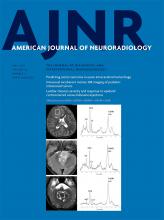Table of Contents
Perspectives
General Contents
- Predicting Motor Outcome in Acute Intracerebral Hemorrhage
The authors prospectively studied patients with motor deficits secondary to primary intracerebral hemorrhage within the first 12 hours of symptom onset. Patients underwent multimodal MR imaging including DTI. Intracerebral hemorrhage, perihematomal edema location and volume, and corticospinal tract involvement were assessed. The corticospinal tract was considered affected when the tractogram passed through the intracerebral hemorrhage and/or the perihematomal edema. The authors calculated affected corticospinal tract-to-unaffected corticospinal tract ratios for fractional anisotropy, mean diffusivity, and axial and radial diffusivities. Significant independent predictors of motor outcome were NIHSS and modified NIHSS at admission, posterior limb of the internal capsule involvement by intracerebral hemorrhage at admission, intracerebral hemorrhage volume at admission, 72-hour NIHSS, and 72-hour modified NIHSS. The sensitivity, specificity, and positive and negative predictive values for poor motor outcome at 3 months by a combined modified NIHSS of >6 and posterior limb of the internal capsule involvement in the first 12 hours from symptom onset were 84%, 79%, 65%, and 92%, respectively.
- Usefulness of Silent MR Angiography for Intracranial Aneurysms Treated with a Flow-Diverter Device
Silent MRA is a procedure using an ultrashort TE and arterial spin-labeling techniques, which efficiently visualizes the status after the treatment of intracranial aneurysms. In Silent MRA, the 3D image is reconstructed by subtracting the control image from the image obtained by the labeling pulse. Seventy-eight large, unruptured internal carotid aneurysms in 78 patients were the subjects of this study. After 6 months of treatment, they underwent follow-up digital subtraction angiography, Silent MRA, and TOF-MRA, performed simultaneously. The authors found Silent MRA is superior for visualizing blood flow images inside flow-diverter devices compared with TOF-MRA. Furthermore, Silent MRA enables the assessment of aneurysmal embolization status. Silent MRA is useful for assessing the status of large and giant unruptured internal carotid aneurysms after flow-diverter placement.
- Pediatric Atypical Teratoid/Rhabdoid Tumors of the Brain: Identification of Metabolic Subgroups Using In Vivo 1H-MR Spectroscopy
Twenty patients with confirmed atypical teratoid/rhabdoid tumors who underwent MR spectroscopy were included in this study. In vivo metabolite levels of atypical teratoid/rhabdoid tumors were compared with molecular subtypes assessed by achaete-scute homolog 1 expression. In vivo creatine concentrations were higher in tumors that demonstrated achaete-scute homolog 1 expression compared with those without achaete-scute homolog 1 expression. Additionally, levels of myo-inositol were significantly different, whereas lipids approached significance in these 2 cohorts. Higher brain-specific creatine kinase levels were observed in the cohort with achaete-scute homolog 1 expression.
- Intravoxel Incoherent Motion MR Imaging of Pediatric Intracranial Tumors: Correlation with Histology and Diagnostic Utility
Between April 2013 and September 2015, seventeen children with intracranial tumors were included in this retrospective study. Intravoxel incoherent motion parameters were fitted using 13 b-values for a biexponential model. The perfusion-free diffusion coefficient, pseudodiffusion coefficient, and perfusion fraction were measured in high- and low-grade tumors. The authors found significant correlations between the histology and IVIM parameters of different pediatric intracranial tumors. These results suggest that IVIM imaging reflects cell density and vascularity across different types of pediatric brain tumors. They also demonstrated that both the diffusion and perfusion parameters measured on IVIM imaging are useful for grading intracranial neuroectodermal tumors in pediatric patients.
- Focal Cortical Dysplasia and Refractory Epilepsy: Role of Multimodality Imaging and Outcome of Surgery
The authors performed a retrospective analysis of data from 188 consecutive patients with focal cortical dysplasia and refractory epilepsy with at least 2 years of postsurgery follow-up. Predictors of seizure freedom and the sensitivity of neuroimaging modalities were analyzed. MR imaging showed clear-cut FCD in 136 (72.3%) patients. Interictal FDG-PET showed focal hypo-/hypermetabolism in 144 (76.6%); in 110 patients in whom ictal SPECT was performed, focal hyperperfusion was noted in 77 (70.3%). Focal resection was the most common surgery performed in 112 (59.6%) patients. Histopathology revealed type I FCD in 102 (54.3%) patients. At last follow-up, 124 (66.0%) were seizure-free. Complete resection of FCD and type II FCD were predictors of seizure freedom. Localization of FCD on either MR imaging or PET or ictal SPECT had the highest sensitivity for seizure freedom at 97.5%. They conclude that during presurgical multimodality evaluation, localization of the extent of the epileptogenic zone in at least 2 imaging modalities helps achieve seizure freedom in about two-thirds of patients with refractory epilepsy due to FCD. FDG-PET is the most sensitive imaging modality for seizure freedom, especially in patients with type I FCD.
- Lumbar Spinal Stenosis Severity by CT or MRI Does Not Predict Response to Epidural Corticosteroid versus Lidocaine Injections
In this secondary analysis of the CT and MR imaging studies of the prospective, double-blind Lumbar Epidural Steroid Injections for Spinal Stenosis (LESS) trial participants, the authors found no differences in baseline imaging characteristics between those receiving epidural corticosteroid and lidocaine and those receiving lidocaine alone injections. No imaging measures of spinal stenosis were associated with a differential response to corticosteroids, indicating that imaging parameters of spinal stenosis did not predict a response to epidural corticosteroids.
35 Years Ago in AJNR
Online Features
Letters








